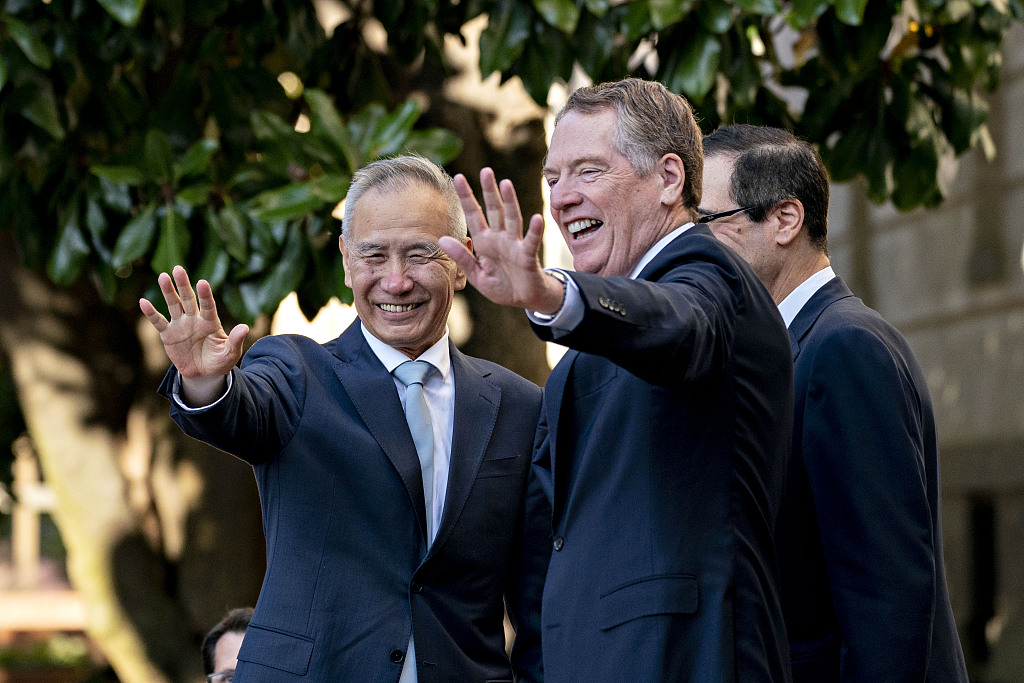Editor's Note: Tom Fowdy is a British political and international relations analyst and a graduate of Durham and Oxford universities. He writes on topics pertaining to China, the DPRK, Britain, and the United States. The article reflects the author's opinions and not necessarily the views of CGTN.
On November 7, White House economic advisor Larry Kudlow stated in the view of U.S.-China trade negotiations, "If there's a phase one trade deal, there are going to be tariff agreements and concessions." The comments came on the back from a statement from China's Ministry of Commerce stating, "In the past two weeks, top negotiators had serious, constructive discussions and agreed to remove the additional tariffs in phases as progress is made on the agreement."
White House adviser Kellyanne Conway also stated that Trump is "anxious" to sign a deal. Nevertheless, owing to the cancellation of the APEC summit in Chile, which was the originally intended destination, no location or time has yet been scheduled. There has also reportedly been some dispute among members of Trump's cabinet as to how much in tariff concessions should be given, with some hardliners reportedly opposed to relenting tariffs. Nevertheless, the decision was made.
On this note, it is fair to assess that this phase one deal is serious, with markets treating it as such. Although critics will note that the trade war has had many "false dawns" where talks were abruptly U-turned into escalation by Trump, these talks were always pre-empted by an open threat of further tariffs. In contrast, this window is distinctly different from the fact that official rhetoric, for the first time, is openly committing to removing tariffs than to adding more. The political weight Trump places on securing this agreement shows, and this makes it significantly easier for disagreements to be overcome. Finally, there is light at the end of the tunnel.
For the entire process of the trade war, Trump's modus operandi was very clear. The White House would threaten measures against China, give space for dialogue and then impose those measures if it deemed its demands were not being met. This created a rinse and repeat cycle whereby windows of dialogue and apparent breakthroughs were abruptly ended by Trump going ahead with tariff threats. It gave the impression that the United States were not interested in compromise, and there seemed to be no ceiling on how far Trump was prepared to push, even if it meant placing levies on all of U.S. imports to China.

Liu He, China's vice premier, left, and Robert Lighthizer, U.S. trade representative, wave to members of the media before a meeting at the Office of the U.S. Trade Representative in Washington, D.C., U.S., October 11, 2019. /VCG Photo
Liu He, China's vice premier, left, and Robert Lighthizer, U.S. trade representative, wave to members of the media before a meeting at the Office of the U.S. Trade Representative in Washington, D.C., U.S., October 11, 2019. /VCG Photo
Then suddenly, things changed. The potential reasons have been discussed frequently. One might take a look at the slowing U.S. economy, the growing damage to U.S. agriculture, Trump's growing political weakness in the face of impeachment and his election prospects next year. These factors combined have made it extremely costly for Trump to push any further, and as a result, he appears to have become serious about wrapping things up or at least stabilizing things.
The rhetoric proves this. Never before has the administration actually made a public confirmation that they are prepared to remove tariffs in exchange for an agreement. As noted above, the public impetus of negotiations for the past year has always been the open threat of more tariffs and measures against China and no offer of reward. In this window of negotiations, while there have been some indirectly leaked rumors, there have been no such threats. Instead, all rhetoric has been leveled toward the prospect of some form of a deal. It should not be played down. By this administration's standards, the call to remove some tariffs is huge.
Of course, the exact details of what will be removed and when are yet to be confirmed. As negotiations proceed, these specifics and how much they will connect to the rhetoric are still very much in the air. The proposed removals have been described as "phased," which means Washington may sustain some until they feel certain commitments are met in the attempt to place the burden of impetus on Beijing. At a starting point, one may likely expect the pending tariffs scheduled to go in place in December to be canceled, capping existing ones at 200 billion U.S. dollars. Thus, this latter figure is likely the one which will be taken down in steps and, of course, potentially beyond "phase one" commitments, which is important to consider given the pathway yet to go in U.S.-China negotiations.
As a whole, the latest announcement brings a great deal to be optimistic about, even if the details are not yet finalized. Negotiations are continuing to progress, and the administration is continuing to send out a series of consistent and positive vibes, which reaffirm their commitment to clinching a "phase one" deal. The open announcement that an agreement on canceling tariffs will be part of this outcome is a significant shift in White House discourse, which sets it apart from previous windows of dialogue. There is finally light at the end of the trade war tunnel, which is a huge relief for everyone.
(If you want to contribute and have specific expertise, please contact us at opinions@cgtn.com.)